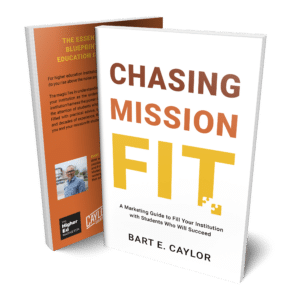How to Create a Generative AI Playbook for Small College Marketing Teams
Build smarter campaigns with this generative AI playbook for small college marketing—tools, workflows, and staff training that actually work.
social media
If your social media strategy isn’t generating inquiries or applications, it’s time to rethink the plan.
For many small colleges and universities, social media feels like a daily grind—posting, liking, and boosting content just to stay visible.
But visibility alone doesn’t fill seats.
Posts that increase your visibility should be a part of your brand awareness goals, but that is not the same as lead generation.
And when enrollment is your goal (as it should be for any healthy institution) the difference matters.
In this post, we’ll break down how to build a social media strategy that leads with results.
That is, I want to show you the steps I take to craft social media strategies that move beyond vanity metrics and actually drive enrollment from mission-fit students.
Until recently, social media platforms prioritized reach based largely on follower count.
That meant if your account had a large audience, your posts were more likely to appear in users’ feeds—regardless of how engaging the content was.
As a result, the strategy for many institutions centered on gaining more followers, often through content designed to maximize visibility rather than generating action.
Brand awareness content fit this model perfectly because it was optimized for reach and visibility, not necessarily engagement or conversion.
Posts featuring campus beauty shots, inspirational quotes, or high-level messaging were easy to produce, broadly appealing, and safe from scrutiny.
They helped institutions look active and polished without requiring much interaction from the audience.
This type of content served its purpose when follower count was the primary metric that influenced reach.
The more followers you had, the more exposure you could expect from simply showing up.
But with today’s algorithms favoring engagement over follower count, that approach no longer delivers the results enrollment marketers need.

Recent changes in social media algorithms actually reinforce this lead-first approach.
Today, platforms like TikTok, Instagram, and Facebook prioritize content that performs well—not content that comes from accounts with the most followers.
That means content that sparks engagement, saves, comments, and shares is rewarded with broader reach.
It answers real questions, solves real problems, and gives prospective students something they can act on.
A scholarship checklist or behind-the-scenes video of campus life is far more likely to engage users than a generic brand message.
In other words, the same content that generates leads is the content algorithms now favor.
But focusing on lead gen content doesn’t mean you have to leave your brand awareness goals behind.
At Caylor Solutions, we’ve seen how prioritizing lead generation can actually build brand awareness organically—without the need for expensive, broad-based awareness campaigns.
So the goal should be to show up with value.
Every post should point toward deeper engagement, whether that’s a downloadable guide, a campus visit form, or a personal story that leads someone to raise their hand.
If your audience is “everyone,” your content won’t resonate with anyone.
Start by defining your mission-fit student personas.
What are their values, fears, goals, and daily habits? Where do they spend time online?
For faith-based colleges, that might include churchgoing teens, homeschooled students, or adult learners returning for purpose-driven careers.
For regional public universities, that could mean first-generation students, community college transfers, or working adults seeking degree completion.
For elite liberal arts colleges, it might include high-achieving high schoolers involved in the arts or social justice initiatives, students exploring identity and values, or those looking for a tight-knit academic community with faculty mentorship.
And for career-focused institutions, target personas could include students pursuing quick-entry career paths, adult learners focused on ROI, or learners looking for online flexibility and industry certification.
Whoever your marketing persona is, your content should reflect their questions, not your institutional talking points.
You don’t have to be everywhere.
Focus your efforts on the platforms where your audience is most active—and where you can consistently create authentic, engaging content.
Avoid spreading yourself thin. Consistency and quality beat quantity every time.

Build a simple calendar with a mix of content that balances awareness, engagement, and conversion.
Use the “80/20” rule:
Every post should either build trust or invite a next step.
And don’t forget to plan for repurposing.
For example, you can turn blog posts into quote graphics, videos into reels, or alumni stories into email teasers.
Lead magnets turn anonymous followers into known prospects.
These are downloadable or gated pieces of content that provide real value like a scholarship guide, checklist for applying, or virtual or in-person campus tour.
Promote them regularly in your content, using clear calls to action. This is how you move from awareness to inquiry.
Likes don’t equal leads.
It’s easy to feel good about social metrics like likes, shares, and comments.
But unless those engagements are moving prospective students toward inquiry or application, they don’t help you meet your goals.
Instead, focus on the metrics that matter most to enrollment: link clicks to key landing pages, form completions, and conversion rates from social campaigns.
Tools like UTM tracking and Google Analytics can help you connect the dots between a social post and a new inquiry or applicant.
Review this data regularly to identify what content drives action.
Use those insights to guide your future strategy—not whatever happens to be trending that week.
That’s how you build a social media strategy that serves enrollment first.
Your social media feed shouldn’t just be a collection of posts. It should be a cohesive strategy built around purpose and outcomes.
When you build content around the real questions your students are asking, share stories that invite connection, and provide calls to action that are easy to follow, you equip your social media presence to actually drive enrollment rather than just engagement.
Lead generation isn’t a marketing add-on.
It’s the core strategy that turns visibility into enrollment. Done right, it builds authentic brand awareness along the way.
Stay focused on what moves students forward, and every post can become a step toward mission-fit enrollment.
Want Help Turning Your Social Media Strategy into Action?
Knowing what to post is one thing—executing a consistent, enrollment-focused plan is another.
That’s where we come in.
Caylor Solutions offers comprehensive Social Media Strategy, Planning & Management services designed specifically for colleges and universities that want to move beyond vanity metrics.
We’ll help you:
Whether you’re starting from scratch or looking to fine-tune your current approach, we’ll ensure your social content is more than active—it’s effective.
Let’s make every post count. Talk to us about your social media strategy.
The essential marketing book every higher education institution needs! If you are a higher education marketing professional seeking a fail-safe plan to make your institution stand out, “Chasing Mission Fit” is your guide.
 Discover how to:
Discover how to:
So you can empower your institution with audience-focused marketing strategies, and attract mission-fit students who will flourish in your unique academic environment.
Ready to transform your institution’s marketing approach?
Order now!
Images via Midjourney
Subscribe to The Higher Ed Marketer podcast today!